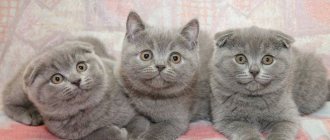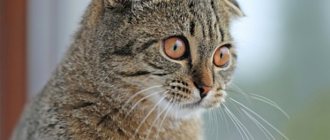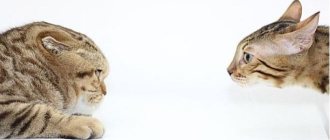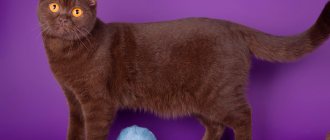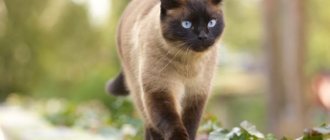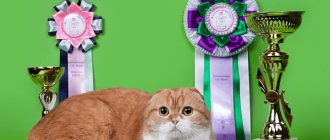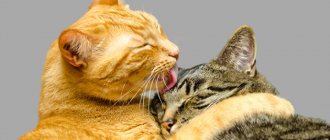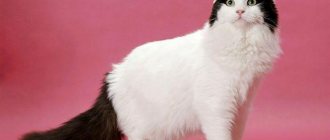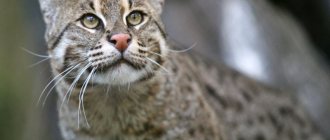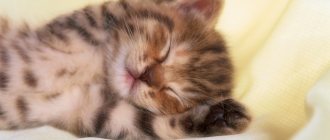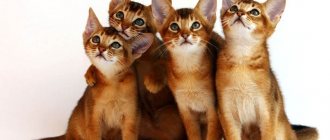- April 17, 2019
- Cats
- Victor Sobolev
The Blue Scottish Fold, otherwise known as the Scottish Fold, is a beautiful breed with a little quirk. Her ears are lowered down, but do not cause any discomfort to the animal. Blue Scottish Fold cats are very beautiful and very popular. As is typical of a true Scot, Scottish Folds are surprisingly calm, intelligent and are able to give their owner irreplaceable comfort in the home. In this article you can learn about the standard of the Scottish Fold cat breed, the characteristics of the animal, its character and possible difficulties.
Breed standard
This is a medium-sized animal, belonging to the short-haired type, with curled ears. Moreover, babies are born with straight ears, but after a few weeks they droop. The coat of a Scottish Fold cat is short and thick, with a pleasant softness to the touch. The body build is dense and powerful. The legs are of medium length, with large pads on the paws. The eye color of blue Scottish Fold cats is usually almond-shaped. In kittens they may be a different color, which will change over time. The weight of the pet varies from 3 to 6 kilograms, depending on gender. The size of the Scottish Fold cat is approximately 28-30 cm.
Description of the Scottish straight cat
Scottish Straight cat breed is often confused with its British ancestors. At first glance, similar representatives of the cat world have a number of differences. Below are the most striking of them:
- Scottish Straight cats weigh less;
- their slimmer, more graceful body is more flexible and agile than that of the British;
- In Scottish cats, the roundness of the skull is more pronounced.
The proportionally large head is attached to the body by a short, thick neck. The rounded, convex skull is hidden behind a wide muzzle. The line of a strong, barely protruding chin is softened by large cheeks. In males they are fuller. The moderately wide and short nose looks like a dark button. A small depression between the eyes, at the base of the olfactory organ, gives the profile of the Scottish Straight cat a special charm and slight pride.
The most important feature of the Straight's exterior is its erect ears. Their “locators” are either medium-sized or small. Scottish ears are located high on the head and wide relative to each other. The outer contour is noticeably lowered, but the straight-eared Scots do not resemble their fold-eared brothers in this way. The tips of the hearing organs, spread out to the sides, are rounded.
Representatives of the Scottish Straight breed have large round eyes. One gets the feeling that a trusting cat’s gaze can penetrate the depths of the human soul. When creating the palette of iris colors, nature was very generous. These are deep and rich shades that match the color of the fur.
Scottish Straight cats have a thick, plush coat consisting of thin, silky hairs and dense undercoat that hugs the body. The coat can be either moderately long or short. A long-haired cat has shorter fur on its paws and face than on the rest of its body. A light mane is noticeable on the neck, the tail is decorated with a plume.
global $ads_google; //data-ad-slot=”2475549904″ $ads_google = empty($ads_google) ? false : true; ?> if ($ads_google == false) {?> $ads_google = true; ?> } ?>
There are a variety of fur colors for cats from Scotland:
- plain;
- tortoiseshells (they say that a tricolor cat brings great happiness to the house);
- marble (in simple terms - “whiskas”).
- tabby
- striped
- bicolor
- ticked
For short-haired straight-eared dogs, any colors are acceptable. The most popular colors of the breed's fur coat are:
| black | red | blue point |
| white | seal point | brown |
| lilac | golden | cinnamon |
| ginger | harlequin | silver |
| cream | smoky | chocolate |
| black smoke | chinchilla | color point |
| blue | peach | grey |
| silver blue | faun | mackerel |
The rarest color is lilac, so these cats are more expensive.
Some of the popular colors are marble on gold and marble on silver, as well as chinchilla colors.
Dimensions and weight of Scottish Straight cats
Scottish Straights look like cute teddy bears, which are also not devoid of feline grace and elegance. These are medium sized kitties. The Scottish Straight breed has clearly expressed sexual dimorphism: males are much larger than females.
Females weigh about 3.5-5 kg, males - 5-7 kg.
Despite their external softness, they have a muscular body, with powerful, strong bones.
The width of the body from the shoulder line to the hips is approximately the same. The smoothly outlined carcass of the Scottish has rounded contours. Dense, stocky Scottish Straight cats move on relatively short, plump legs. The pads are oval, massive, with clenched toes. The limbs are proportional to the size of the body. The long tail is equal to the distance from its base to the middle of the shoulder blades, and noticeably tapers towards the tip. Scottish Straight weight table by month
| Age | Female | Male |
| 1 month | 300-600 gr | 450-700 gr |
| 2 months | 450-750 gr | 850-1500 gr |
| 3 months | 1.25-1.60 kg | 1.35-2.4 kg |
| 4 months | 1.75-2.35 kg | 2-3.6 kg |
| 5 months | 2.20-3.15 kg | 2.45-4.2 kg |
| 6 months | 2.35-3.55 kg | 3-5.5 kg |
| 8 months | 2.9-4.25 kg | 3.45-6.1 kg |
| 10 months | 3.1-4.60 kg | 4.2-7.1 kg |
| 1 year | 3.2-5.4 kg | 4.6-7.4 kg |
| 2 years | 3.4-5.65 kg | 5.3-8.2 kg |
Description of the blue Scottish fold cat
As a rule, it is believed that there are practically no incidents with these beautiful creatures. By nature, blue Scottish Fold cats are quite calm and affectionate. As children, they quickly get used to a new place and household thanks to their natural friendliness. They love their owners so much that they are ready to follow them on their heels, while doing so unobtrusively. The Scots have a stable and balanced psyche. They get along well not only with children and animals, but even with strangers. Scottish Fold cats have normal health and cleanliness.
As with any other living beings, there are some problems with the Scots. This usually occurs when the cat is still young and full of energy. Young Scottish Folds are very active and can run around rooms for hours. But adult individuals have a phlegmatic disposition and would rather sit on their owner’s lap than play and run around.
History of the breed
Highland Folds were bred in the seventies of the last century through artificial selection in the wake of the popularity of Scottish Folds. To create a new breed, the British were crossed with Persian cats , and then with Scottish Folds , resulting in semi-long-haired kittens with rounded features, a variety of colors and tightly folded small ears.
Important! The Highland Fold should not be confused with the Highland Straight: in the second case, the cat’s ears are straight, not drooping.
The breed is recognized by such organizations as:
- Scottish Fold Longhair
- TICA
- CFA
- CCA
- Highland Fold
- WCF
- ACFA
Scottish fold cost
The price of a kitten depends on what the future owners plan to get a pet for. For people for whom it is fundamentally important to get a purebred show-class kitten for its subsequent participation in exhibitions, the cost will be at least 50 thousand. If they buy a baby just for the soul and its origin is not so important for the family, then it is quite possible to purchase an animal for between 10-30 thousand rubles. The Blue Scottish Fold cat is a fairly common breed. You can buy it in almost any city.
Chinchillas
Just like the smoky cat, it has partially dyed pile. Only if the last representative of the cat family has silvery roots, the chinchilla, on the contrary, is characterized by almost completely white hair. Only 1/8 of the cover is colored. Due to this, the animal’s fur coat seems to have a sputtering effect.
IMPORTANT: Such cats always have a dark outline around the eyes, nose, and lips.
The eyes themselves have a stunning green tint. The nose and paw pads are most often pink.
When it comes to base coverage, there are plenty to choose from. Experts count at least a dozen colors of chinchillas. For example, this is cameo, cream, chocolate, lilac, blue. The most rare is the golden-blue chinchilla.
The character of such animals is also calm. But at the same time, they are not averse to actively playing or showing character from time to time.
Blue Scottish Fold cat: care and maintenance features
The little Scottish Fold is a real livelier, bursting with energy. When a new family member arrives, you will need to buy the following supplies for his comfortable living in the house:
- two bowls - for food and drink;
- toys - to distract the baby’s attention and not play with him with his hands;
- scratching post;
- combing brush;
- tray;
- basket or sleeping mat.
Before the kitten arrives, you should remove all objects that are dangerous to it: sockets, wires and small things that it could accidentally swallow.
The house must be clean so that the little fragile creature does not get sick.
Keeping a blue Scottish Fold cat will cost owners no more than any other breed.
It's easy to care for. To keep the fur looking neat, it is enough to brush your pet two to three times a week. During the molting period, the procedure is carried out more often.
Ears, eyes and nose should always be clean. If any discharge appears, it should be removed immediately using a cotton pad soaked in water. You need to bathe your cat no more than once every six months.
To the peculiarities of caring for a blue Scottish fold cat, we can add that these creatures are sometimes susceptible to diseases of the joints, eyes and skin. For this reason, you need to closely monitor the animal.
Standard
The standard of Highland Folds and Scottish Folds is almost the same: the only differences are in coat color.
| Standard | Description |
| Head | Round, rather wide, forehead slightly sloping. The cheeks are plump and round. There are sideburns. The nose is short, with a wide bridge. The stop is clearly pronounced. The chin is rounded and strong. |
| Eyes | Large, round, golden yellow, widely spaced. |
| Ears | Very small, pressed tightly to the head, their tips are curled. Folded 2 times: forward and backward. |
| Torso | Compact, medium size, with smooth lines. The muscles are well developed, the shoulders and back are wide, the chest protrudes forward. The neck is thick and short. |
| Limbs | Short, powerful, with wide round legs. There are 4 toes on the hind legs and 5 on the front legs. |
| Tail | Thick, but flexible, without creases or knots. The length is average. A short tail is considered a defect. |
| Wool | Fluffy, soft, semi-long. The undercoat is very thick. “Panties” are noticeable in the area of the hind legs, and a “collar” is visible on the neck. |
There are 3 degrees of lop ears:
- When the ear fits tightly to the skull. Individuals whose ears are almost invisible are valued higher than others.
- 2 folds.
- 1 fold.
The standard allows for small white “medallions” on the chest and textural changes in the coat (only during molting).
Serious disadvantages:
- drooping eyebrows;
- thick and short limbs;
- sharp features of the muzzle;
- thinness.
An animal is removed from the competition if its tail is too thin, or if its tail has knots or kinks.
What should you teach your cat?
All pets must be trained to a certain discipline. A cat is not a dog, and it is unlikely that it will unquestioningly follow commands to please its owner. But even such an independent and freedom-loving creature must know the norms of behavior - what can be done and what cannot be done.
Thanks to their high intelligence and quick wit, blue Scottish Fold cats grasp everything literally on the fly, and raising an exemplary pet who will fill life with only joyful moments will not be difficult.
So, what should a domestic cat know and be able to do?
Sharpen your claws only on a scratching post
Claws are an important attribute of any cat. With their help, the animal climbs trees and other surfaces, and also uses them as a means of defense. Sharpening claws, doing a kind of manicure, is a natural need for a pet. Unknowingly, cats begin to tear up everything that gets in their way: furniture, carpets, wallpaper. To avoid this, you need to accustom your pet to order. Every time a cat starts sharpening its claws in an inappropriate place, immediately pick up the animal and bring it to the scratching post. This needs to be repeated several times. Gradually, the animal learns to sharpen its claws where it is needed.
Tortie colors
Many people mistakenly think that tortoiseshell is a tricolor color. This is actually a palette of two combinations. The basic principle is a combination of cream or red spots with darker ones. Examples: chocolate and red, blue and cream, red and black, cream and lilac.
IMPORTANT: Judges at exhibitions will definitely focus on the harmonious distribution of tones and their saturation.
Another important fact: it is believed that only cats have fur coats. Cats can't be painted like that. If you see a cake cat in front of your eyes, it means there is a genetic failure. As practice shows, such individuals cannot become parents, so they are not suitable for selection.
Cat turtles have copper eyes. The nose and paw pads are black or pink.
Pet health
In general, cats of this breed have good health, but are sometimes susceptible to certain diseases. Often, pets suffer due to improper mating when Scottish Folds are mated with each other, which is absolutely forbidden to do. The list of common diseases includes:
- entropion of the eyelid;
- allergy;
- deafness.
In addition to the above diseases, Scots in adulthood have problems with the digestive tract and the functioning of the cardiovascular system. To avoid them, you need to monitor your pet’s condition and take him to the veterinarian more often.
Catering
The attractiveness of Highland Folds directly depends on what they eat. If the food is unbalanced, poor in vitamins and microelements, and does not contain enough proteins, fats and other important components, the luxurious beauty will quickly turn into an exhausted creature, with dull and sparse hair, a dull look and a bunch of health problems.
Breeders are recommended to feed these cats natural food. The reason is not only the “capricious” stomach, but the fact that the owner will be able to independently control the quality of the products.
Natural products
A natural menu should include:
- Meat. It is an essential source of proteins, taurine and amino acids. The meat is first cut into small pieces (1-2 cm), fat and skin are removed, frozen for 2-3 days (to destroy parasites and their eggs), and before feeding, scald with boiling water and cool. Highland Folds are allowed to eat chicken, beef, turkey, horse meat, veal, rabbit and lamb meat, as well as offal (liver, heart, ventricles). Chicken necks and cartilage are ground, but minced meat should not be given: if the load on the teeth is lost, they will collapse over time).
- Fish. Contains vitamins D, A, B1, B2, omega 3 and omega 6, minerals, but there is little calcium in fish. In large quantities, it destroys vitamin B1, causes iron deficiency anemia, depigmentation of the coat, and is often infected with helminths. Captive-grown fish often contain antibiotics, while river fish often contain heavy metals. Fish is not given every day, but a maximum of once a week, a small piece, preferably not separately, but mixed with porridge. The following varieties are allowed: hake, cod, flounder, sea bass, blue whiting, haddock, capelin, ruffe, tench, navaga, pollock, salmon, tuna. The fish is boiled, cleaned of bones, fins and heads. It is allowed from time to time to pamper the animal with seafood: shrimp, squid, rapana, lobsters, lobsters, mussels, crayfish.
- Vegetables. Cats are indifferent to raw food, so everything will have to be boiled or stewed. Pumpkin, zucchini, beets, cauliflower, broccoli, and spinach are allowed.
- Porridge. Rice, buckwheat, oatmeal, pearl barley, barley. They are boiled in water, meat or vegetable broth, and very little milk is added (solely for taste). They give it from a month or two. Add a drop of any vegetable oil (olive, sunflower, flaxseed) and a boiled egg yolk (or a whole quail egg) to the porridge.
- Dairy products. Hard unsalted cheese, yogurt, fermented baked milk, cottage cheese, sour cream: allowed 3-4 times a week.
Water - only clean water (not from the tap, but from a bottle, purified by filter or settling method), at a pleasant drinking temperature (not hot or icy).
The following products are prohibited:
- fresh fresh meat without treatment with water (a source of helminths);
- fried, smoked, salted, canned, dried (retains liquid, upsets the balance of minerals, upsets metabolism);
- waste: skin, feathers, heads, bones, paws (can injure the throat and stomach);
- pork and lamb (fatty), goose, duck and wild bird meat (tough, may be infected with parasites);
- pea porridge and legumes in general (indigestion and flatulence);
- products with cocoa beans (do not decompose and are not excreted from the body);
- alcohol, beer;
- tea, coffee (the cardiovascular system suffers);
- mushrooms (poisoning);
- tomatoes, potatoes, avocados, garlic, onions, sorrel, rhubarb, grapes, dried fruits, fruit seeds (damage to the gastrointestinal tract);
- sweet, salty, sour, smoked, dog food.
It is allowed to give in minimal quantities: potatoes, flour, pastries, milk (if the cat has been accustomed to it since childhood), raw cucumbers, melon, apples, watermelons, fresh corn, semolina, millet and corn porridge.
Recommended food
Below are recommended super-premium and holistic foods. Links with the names of the food are clickable, on them you can, within our website, get acquainted with the descriptions of the food and read reviews from owners of Highland Fold cats.
| Holistic | Super premium | Super premium |
| Alleva Holistic | Monge | Grandin |
What to feed?
To keep your pet happy and healthy, you need to carefully monitor its diet. If the owner plans to feed the cat natural food, then his diet should include the following products:
- meat (beef, turkey, veal);
- boneless fish;
- offal (boiled);
- vegetables;
- eggs.
It is not recommended to feed cats raw, unprocessed meat to avoid infection with helminths. Also, do not give your pet milk. It is useful only for small kittens, but not for adult animals.
Products prohibited for cats include:
- sweets;
- alcohol;
- fatty and fried foods;
- smoked meats
Such food is not only not healthy for the animal, but can also have a detrimental effect on its health and body function.
If the owner decides to feed the pet prepared food, then preference should be given to well-known premium companies, such as Royal Canin or Purina. Scottish Folds happily eat both wet and dry food.
Your cat should always have a bowl of clean, fresh water.
Origin story
The ancestor of Scottish cats is considered to be a cat named Susie, who was born in 1961 and was a carrier of the mutation gene (FdFd), which is why her ears were folded. It was with this cat that work began on the Scottish Fold breed. Breeders sought to consolidate fold ears in their descendants, and to give the breed a pretty appearance, crossbreeding was carried out with other breeds: Persian, Burmese, American Shorthair and British. As a result, the breed developed a rounded head, large round eyes, and lop ears.
Breeders have noticed that if Scottish Folds are crossed with each other, this leads to congenital malformations of kittens (problems with the spine). Then it was decided to cross Folds only with Straights, in order to avoid the harmful effects of the mutation gene for folded ears.
In a litter of Scottish cats, both fold-eared and straight-eared kittens were born, approximately equally, and mainly fold-eared kittens were developed and exhibited. In the 21st century, they decided to eliminate this injustice and recognized the straight-eared Scots as a separate breed with the right to an exhibition career. Straight-eared Scots are no different from folds, with the exception of the shape of the ears and the presence of mutation genes.
Difficulties with Scottish Folds
Scottish Folds are peaceful and affectionate creatures. They love their owner and all family members. There are no particular difficulties with keeping Scottish cats. In childhood, kittens are overly active and can cause some trouble for household members, but with age, the playful baby turns into an important and phlegmatic cat. Fold-eared cats are perfect for families with children and for retirees, but they definitely won’t fit into the environment of people who lead an active lifestyle. Scots shed actively several times a year, and during this period you will have to clean more often. Another problem with keeping a blue fold cat is its insatiable appetite. Especially in castrated and neutered animals. To prevent your pet from gaining excess weight, you need to control your food intake.
In general, turning a blind eye to some difficulties, we can say that the Scottish Fold is a wonderful pet.
Character and temperament
The Scottish Straight is a good-natured, moderately active cat with an independent disposition. The Scottish Straight does not like to sit on his hands for a long time and prefers to explore the territory and play outdoor games. Despite his attachment to his owners, the independent nature of the Scottish straight-eared cat does not allow him to be excessively intrusive. The Scottish Straight will always find something to do, especially if there are enough toys.
On a note. Scottish Straight loves privacy. The Scottish Straight does not need constant contact with its owners and is suitable even for those who spend a lot of time outside the home.
The good-natured nature of the Scottish Straight allows him to get along with children without problems. True, the Scottish Straight Dog does not like to be cuddled, and will in every possible way avoid babies who carry her in their arms.
Scottish Straights get along well with other cats and non-aggressive dogs. But the character and habits of a real hunter prevent representatives of the breed from coexisting peacefully with ornamental rodents and birds. Scottish Straights perceive hamsters and other similar animals as prey. Therefore, it is better not to keep them in the same house.
Owners' opinion
Owners of Scottish Folds often leave comments about their pets. Most owners speak positively about their favorite plush cats. As a rule, they are balanced, intelligent and beautiful. The Scots are kind to all people and animals. But owners often write about problems associated with this breed. These include high activity of the pet at a young age, disobedience, ignoring family members, damage to furniture and fragile health.
Often, most of the problems that a cat creates are the fault of the owner himself, who did not react in time and did not show the pet how to behave correctly. When it comes to health, you need to carefully monitor the condition of the animal and not leave the situation to chance.
Scottish Folds are the smartest and most graceful creatures that, with proper training and care, will be excellent pets.
Tabby options
These representatives can boast of so-called zonal markings on their coats. These are rings on the paws and hosta, patterns on the sides and neck, outlines of the nose and eyes, and an M-shaped pattern on the forehead. Tabbies are divided into the following options:
- Tiger – also known as “mackerel”, “striped”. The pattern, as the name suggests, is stripes. And certainly clear, like a tiger’s. The stripes are usually not wide.
- Spotted – also called “spotted”. In this case, the cat can be compared to a leopard. The spots can be both large and small. As for their locations, there are no restrictions either. The only condition is that the marks must be clear. Let's switch to stripes if the spots stretch along the spine. The paws and tail may also be striped.
- Marbled - considered a classic version of tabby. As for the color of the fur coat, there are no restrictions. It can be red, brown, cream, blue, silver. The main thing is the presence of contrasting stains, reminiscent of marble stripes. Perhaps the most rare is golden marble. Such individuals look really impressive - black streaks on a golden background are an extremely good contrast.
